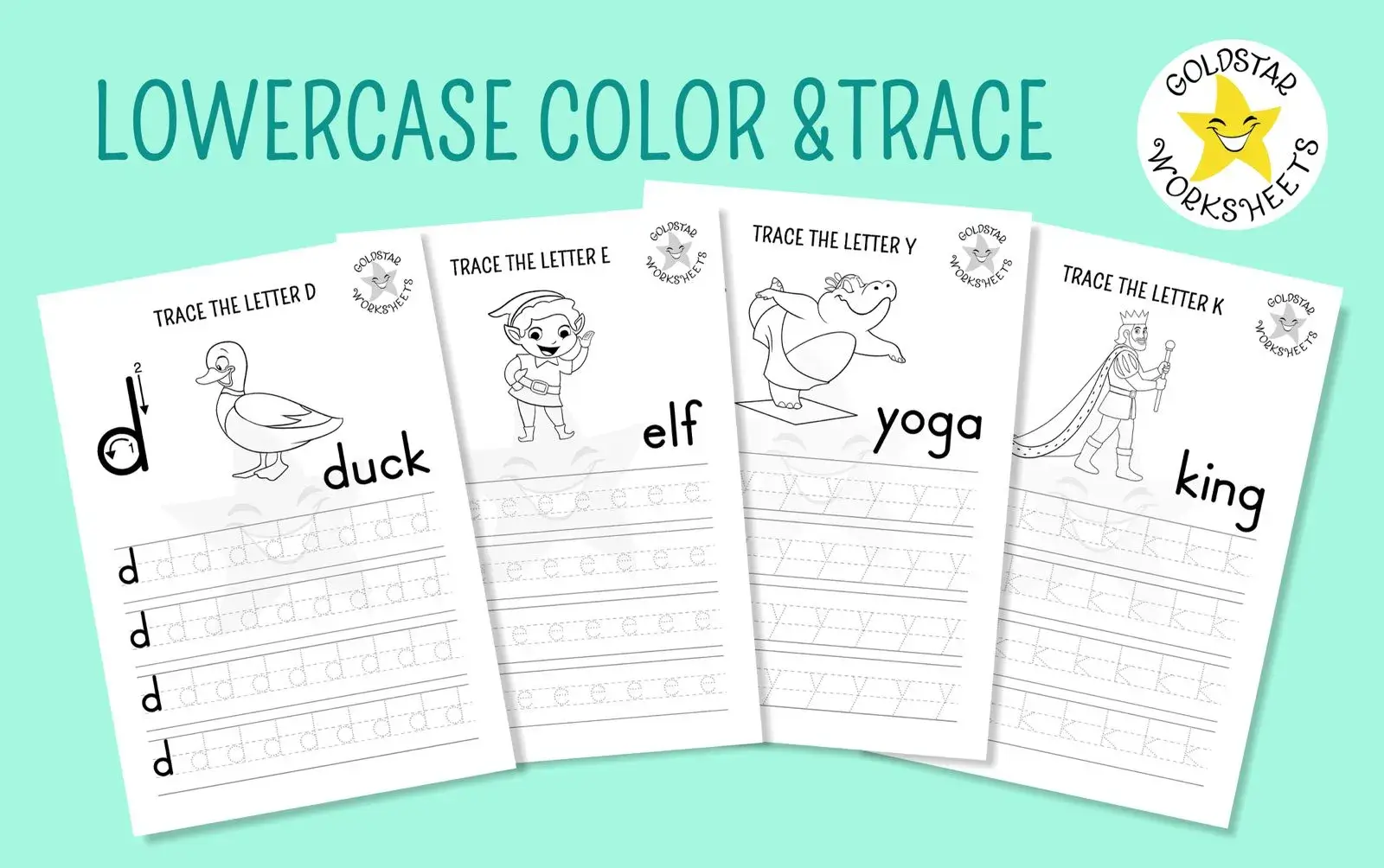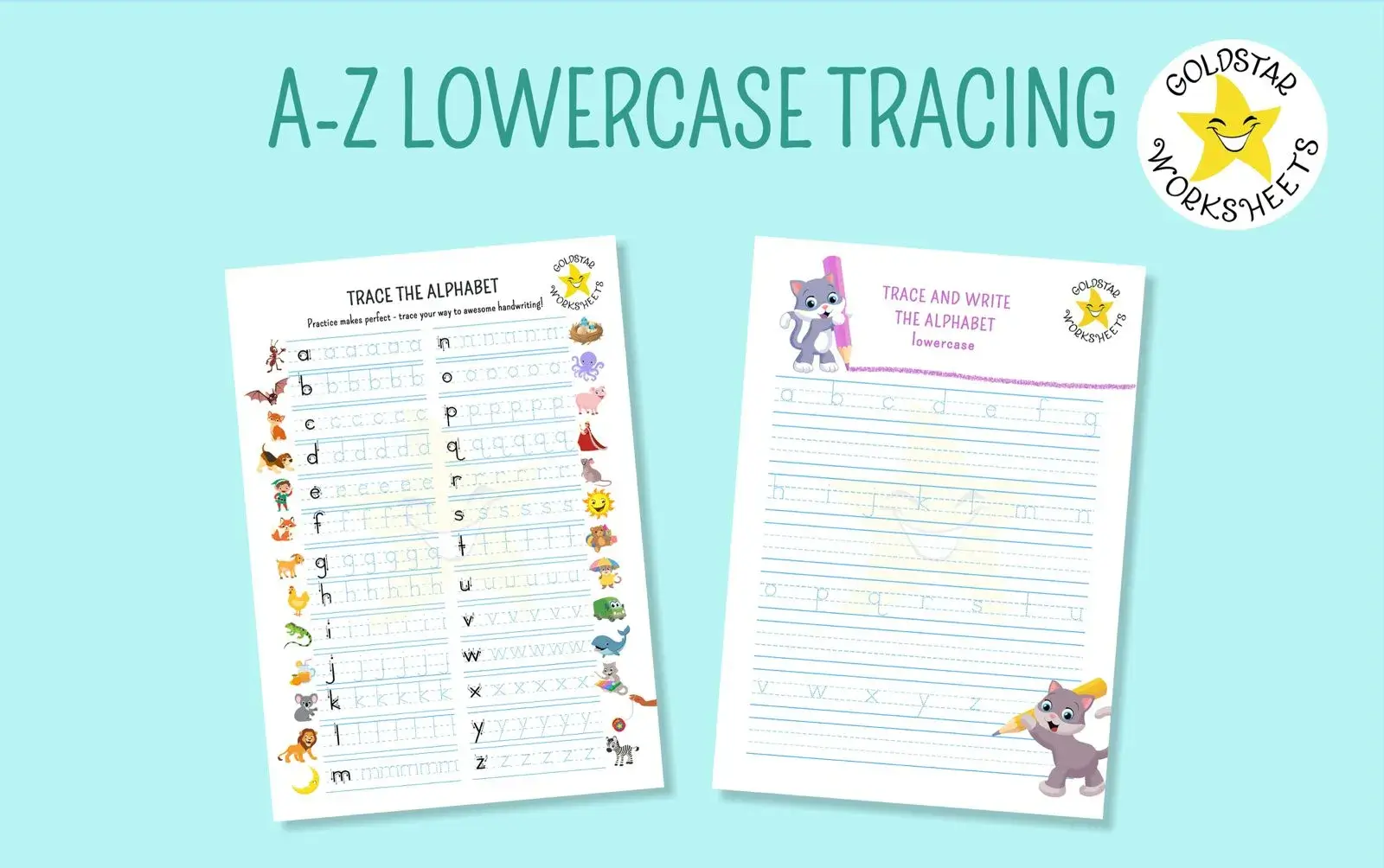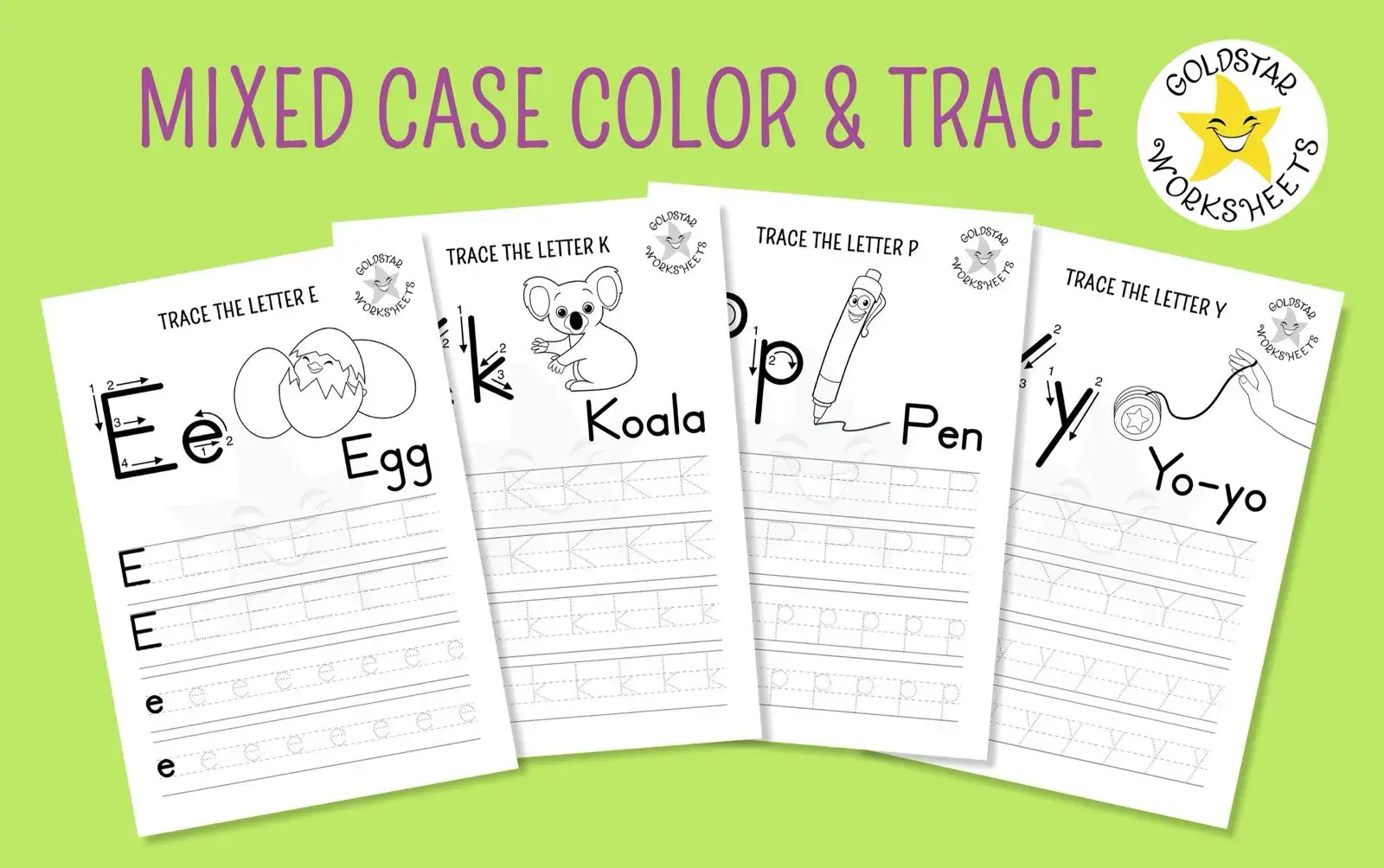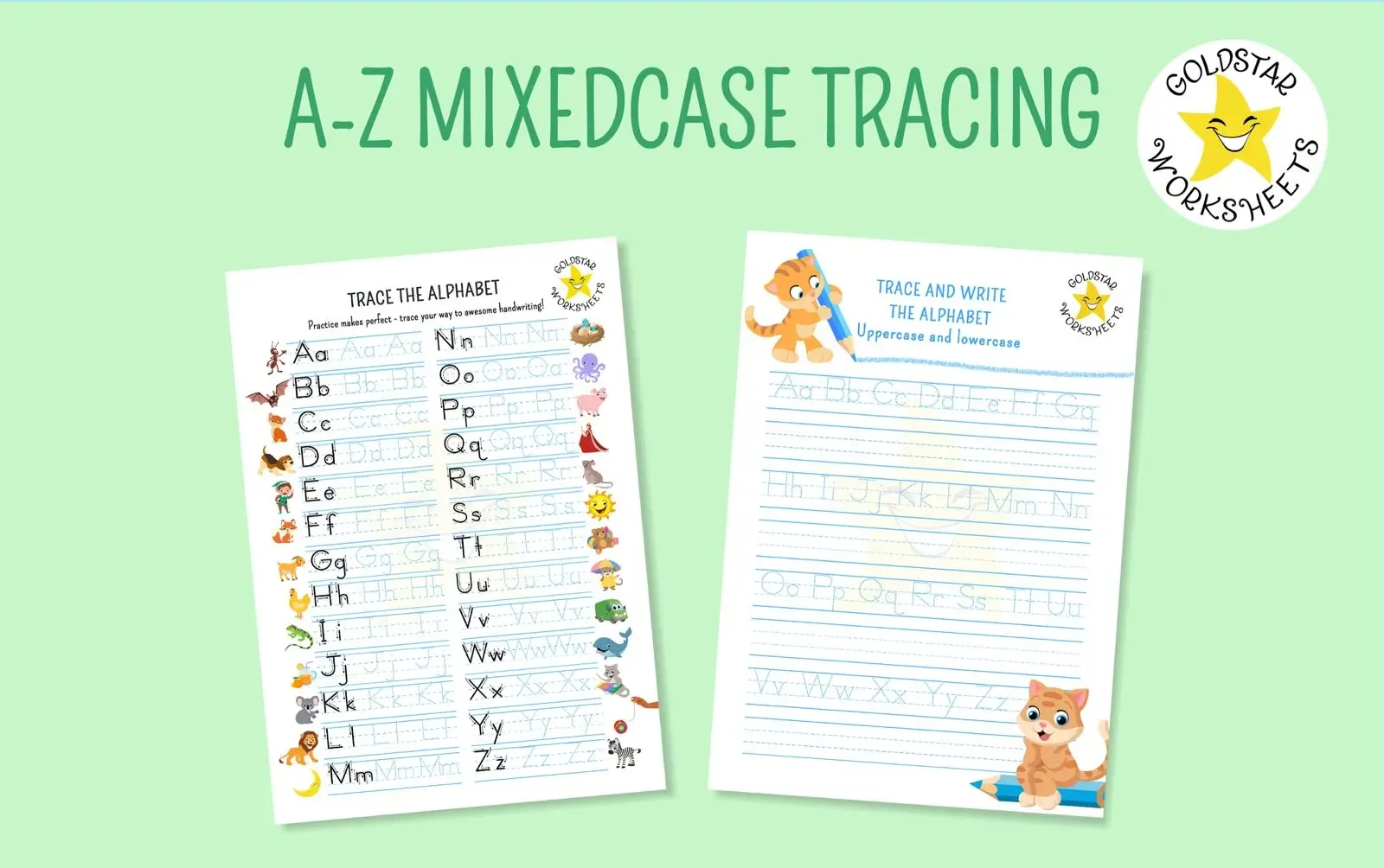- Home
- Free Letter Tracing Worksheets
Free Letter Tracing Worksheets – Uppercase, Lowercase, Mixed, & A–Z on One Page
Free Uppercase Letter Tracing Worksheets
These capital letter tracing worksheets help preschool and kindergarten kids practice writing in a fun, structured, and developmentally appropriate way. Whether your child is learning how to form each letter for the first time or is ready to try writing without the dotted lines, these free printable alphabet worksheets give you everything you need to build your child's confidence and skills — one uppercase letter at a time.
We offer a variety of letter tracing formats, designed to fit different needs. Browse our full collection of 130+ free PDF uppercase tracing sheets, or choose from six capital letter worksheet sets below.
Free Lowercase Letter Tracing Worksheets
Learning to write lowercase letters is a big step for young learners — and often trickier than uppercase! With 7 starting points to learn (compared with 2 in uppercase) and a wider variety of lines to draw, occupational therapists recommend teaching uppercase first. However, with lowercase being used and seen far more often, some educators still prefer to begin with lowercase.
Our 100+ Free PDF lowercase letter tracing worksheets are carefully designed to support developing motor skills, visual recognition, and early writing confidence.
Check out our full collection or choose from the five worksheet sets below.
Free Uppercase & Lowercase Letter Tracing Worksheets
Learning how capital and small letters relate is an exciting step in a child’s writing journey. Our uppercase and lowercase tracing worksheets help children confidently connect the two — building fluency and letter recognition at the same time.
Each worksheet includes letter pairs like Aa, Bb, Cc and so on, helping learners master both versions side by side. These sheets are especially helpful once your child has practiced uppercase or lowercase on their own and is ready to integrate them together.
Choose from our full collection of 100+ free PDF worksheets for tracing uppercase and lowercase (Aa) together, or go directly to the downloads for the worksheet type you want below.
Make Letter Tracing Fun With Gold Star
Learning to write letters can be one of the most joyful — and sometimes challenging — parts of early childhood education. Our free letter tracing worksheets are here to make that journey easier and more fun.
Whether you’re helping a preschooler just beginning to hold a pencil, or a kindergartener gaining confidence in their handwriting, we’ve got you covered.
This page brings together our full collection of over 300 free letter tracing worksheets — thoughtfully designed to match your child’s stage of development. From uppercase and lowercase practice to whole alphabet pages, trace-and-write combos, and fun coloring options, it’s all right here.
Let’s make learning letters simple, effective, and enjoyable.
Recommended Order for Letter Tracing Worksheets
While experts may debate the best approach, we recommend this structured progression to help children build confidence and skills gradually.
| Stage | Worksheet Type | Description | Suggested Age | Key Focus |
|---|---|---|---|---|
| 1. Uppercase Letters (Beginner) | ||||
| Giant single-letter pages | Extra large letters for finger painting | 2-3 years | Letter recognition through sensory play | |
| Uppercase Tracing-only / Color and Trace | Start with simplest letters (L, T, O) | 3-3.5 years | Developing pencil control through basic shapes | |
| Uppercase A-Z Tracing on One Page | Full alphabet practice | 3.5-4 years | Seeing the complete alphabet as a unified system | |
| Uppercase Tracing & Writing / Uppercase Trace, Color, and Write | Transition to independent writing | 4 years | Building confidence in letter formation | |
| Uppercase A-Z Tracing & Writing on One Page | Comprehensive alphabet writing | 4-4.5 years | Developing fluency across all letters | |
| 2. Lowercase Letters (Intermediate) | ||||
| Lowercase Tracing-only / Lowercase Tracing and Coloring | Start with similar-to-uppercase letters (c, o, s) | 4-4.5 years | Understanding size variations and new shapes | |
| Lowercase A-Z Tracing on One Page | Full lowercase alphabet practice | 4.5-5 years | Grasping lowercase as a complete system | |
| Lowercase Tracing & Writing / Lowercase Trace, Color and Write | Independent lowercase writing | 5 years | Precision in smaller letter forms | |
| Lowercase A-Z Tracing & Writing on One Page | Complete lowercase mastery | 5-5.5 years | Fluency in lowercase writing | |
| 3. Mixed-Case Practice (Advanced) | ||||
| Mixed-Case Tracing only / Mixed-Case Trace and Color | Paired letter practice | 5-5.5 years | Understanding case relationships | |
| Mixed-Case A-Z Tracing on One Page | Comprehensive mixed-case practice | 5.5-6 years | Seeing the complete letter system together | |
| Mixed-Case Tracing & Writing / Mixed-Case Trace, Color & Write | Writing both cases together | 6 years | Preparing for sentence writing | |
| Mixed-Case A-Z Tracing & Writing on One Page | Complete alphabet mastery | 6+ years | School readiness and writing confidence | |
Color Guide & Implementation Notes:
- Light blue rows = Beginner Uppercase practice
- Light pink rows = Intermediate Lowercase practice
- Light green rows = Advanced Mixed-case practice
- Worksheet types in dark blue stand out clearly
- Age markers in soft pink for easy reference
- Hover over any row to highlight it for focus
- A-Z pages focus on system-level understanding of the alphabet
- Click on any worksheet type to access that specific set
Little Details That Make a Big Difference
When it comes to alphabet tracing worksheets, the little details matter.
Our free printable worksheets are created by a teacher, psychologist, and designer — all working together to support your child’s development, confidence, and joy in learning. Every letter tracing sheet we create is grounded in what really helps young children thrive.
We use:
✅ Simple, familiar words that preschool and kindergarten kids can recognise and name
✅ CVC (consonant-vowel-consonant) words, which are often the first that early readers learn
✅ Phonetically accurate vocabulary, helping children connect letter formation with letter sounds
This combination supports phonics development, early reading, and handwriting readiness — all in one playful, printable format.
By combining the science of learning with colorful, child-centred design, we’ve created alphabet writing practice worksheets that actually work — and that children love.
What Makes These Worksheets Different?
With hundreds of alphabet tracing worksheets online, why choose ours?
Gold Star Worksheets are:
🌟 Designed for optimal learning – Each page supports letter formation, sound awareness, and pencil control
🌟 Carefully leveled – Whether your child is in pre-K, nursery, kindergarten, or Reception, you'll find formats that match their stage
🌟 Motivating and fun – Friendly animals, engaging images, and cheerful layouts encourage children to keep going
🌟 Flexible for home or classroom use – Print a single page or the whole alphabet; use them as morning work, literacy stations, or early finishers
Need all the Worksheets for a Particular Letter?
Looking for a specific letter? Click a letter below to jump straight to that worksheet — with options for uppercase, lowercase, or both.
📚 Frequently Asked Questions (FAQ)
What age group are these letter tracing worksheets best for?
What age group are these letter tracing worksheets best for?
These worksheets are ideal for preschoolers and kindergarten-aged children — typically ages 3 to 6 — but they can also support older kids who need extra handwriting practice.
Should my child start with uppercase or lowercase letters?
Should my child start with uppercase or lowercase letters?
Most children find uppercase letters easier to begin with because they’re simpler in shape. Once they’re confident, lowercase letters can be introduced, either separately or alongside.
Do you have worksheets that include coloring?
Do you have worksheets that include coloring?
Definitely. Many of our worksheets include pictures to trace and color, helping kids stay engaged while they build fine motor skills and letter recognition.
Are these free to use in classrooms?
Are these free to use in classrooms?
Yes — all our letter tracing worksheets are free for educational use at home, in classrooms, and in childcare settings.
Can I download all the worksheets at once?
Can I download all the worksheets at once?
Yes, you can! Every worksheet is available to download individually for free. If you'd like to save time and get the full A–Z collection in one go, we also offer convenient printable bundles for a small fee.
Get Started with Letter Tracing Today!
Our free alphabet tracing worksheets provide an engaging resource for you to help your little learners build confidence while developing these fundamental skills.
Ready to get started?
We have hundreds of worksheets for you to choose from.
Happy learning!
- Home
- Free Letter Tracing Worksheets




















